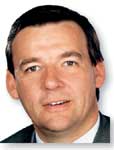Article
Terminology regarding LUTS need to be upgraded
Paris--The term "lower urinary tract symptoms," or LUTS, is controversial because many urologists regard it as a replacement for prostatism, which focuses mainly on voiding dysfunction. But the most bothersome symptoms of LUTS relate to storage, said Christopher Chapple, MD.

"Clearly, we know now that we should be using terminology that relates to either the storage or the voiding phase of the bladder. We do know that obstructive symptoms are the most common, but the storage symptoms, often encompassed by the terms 'overactive bladder' or 'urgency/frequency symptom syndrome,' are the most bothersome," said Dr. Chapple, chair of a committee on new medical developments in the management of LUTS at the International Consultation on New Developments in Prostate Cancer and Prostate Diseases.
"Most of the literature is based on an acceptance that we are dealing with an obstructive problem, therefore, based on flow rates and residuals and symptom assessment using the International Prostate Symptom Score," explained Dr. Chapple, a consultant urologic surgeon at the Royal Hallamshire Hospital, University of Sheffield, United Kingdom. "There has been a failure to appreciate the importance of disorders of storage and, hence, investigate them adequately in the past."
"The IPSS is tried and tested and has been around for a long time. However, it has only three questions of seven dealing with storage. Furthermore, there is insufficient evidence in the literature on how to target therapy based on morphology of the prostate," Dr. Chapple said.
"Biopsies have an enormous sampling error, and we would recommend future research on how best to characterize the morphology of the prostate."
Pharmacologic treatment
The natural history of LUTS and the placebo effect need to be considered in choosing pharmacologic treatment, as the precise mechanisms and sites of action of drugs remain poorly understood. Treatment success is not typically based on relief of obstruction, but on symptomatic improvement, although the exact mechanisms by which this is achieved are poorly defined at present, according to Dr. Chapple.
"We do know that natural history is not necessarily progressive. Symptoms associated with presumed bladder outlet obstruction secondary to benign prostatic hyperplasia tend to fluctuate in severity over the course of time," he noted.
Changes in symptoms during the run-in phase on placebo, which is usually excluded from analyses, should be examined more carefully in the future.
The committee noted the lack of evidence on the long-term efficacy of pharmacologic therapy and the important need to consider patient compliance.
"There is a dearth of information on this in the literature. There is limited long-term data with any of these agents from real-life clinical practice, from noninterventional observational epidemiological studies. Tolerability [of drugs] is in the eye of the beholder," Dr. Chapple explained.
Data need to be interpreted in a more standardized fashion, with criteria taking account of baseline values and including the placebo run-in phase. Cost effectiveness needs to be better established, he said.
Although the actions of the two primary 5-alpha-reductase inhibitors have been well established in the literature, the type 1 enzyme produces less than 1% of dihydrotestosterone in the prostate compared with the type 2 enzyme, said Dr. Chapple. A head-to-head comparison of dutasteride (Avodart) and finasteride (Proscar) in an unpublished study of approximately 800 patients in each group did not show any difference in efficacy or adverse events.
"The efficacy of both these agents, for all intents and purposes, clinically, we have judged to be identical," Dr. Chapple said, noting that the durability of the treatment response with finasteride over 5 years and dutasteride over 2 years has been confirmed in placebo-controlled studies.
Recommendations for other hormonal approaches have not changed since the last consultation.
Alpha-adrenoceptor antagonists appear to show few differences in efficacy in randomized, controlled trials.


